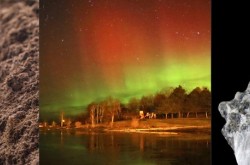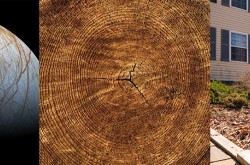Des trous noirs pour tester la relativité générale
Cet article a initialement été rédigé et soumis pour faire partie du recueil de récits d’innovation du projet Canada 150 visant à réunir des témoignages sur l’innovation canadienne en collaboration avec des partenaires de partout au pays. Il a maintenant été intégré au Réseau Ingenium, un portail numérique qui met en vedette du contenu en lien avec les sciences, la technologie et l’innovation.
Des chercheurs de l’Institut Périmètre utilisent des mesures effectuées à l’aide du télescope EHT pour mettre à l’épreuve la théorie d’Einstein avec le trou noir supermassif situé au centre de la Voie lactée.
La meilleure façon de savoir si la théorie de la gravitation d’Einstein a des failles, c’est d’examiner attentivement les régions où la gravité est la plus extrême : les trous noirs.
Heureusement, le télescope EHT&(Event Horizon Telescope – télescope horizon des événements), réseau mondial de radiotélescopes, possède une sensibilité et une résolution extraordinaires qui permettent de faire un tel examen.
Une équipe de chercheurs dirigée par Tim Johannsen et Avery Broderick, de l’Institut Périmètre, a proposé une nouvelle manière d’utiliser des observations de Sagittaire A*, le trou noir supermassif situé au centre de notre galaxie, pour déterminer si les prédictions de la relativité générale se réalisent ou non.
La clé de leurs travaux publiés récemment dans Physical Review Letters est une « ombre » du trou noir révélatrice. Elle se détache en silhouette sur fond du matériau brillant surchauffé qui tombe au-delà de l’horizon des événements. Si les prédictions de la relativité générale sont justes, cette ombre devrait avoir une forme presque parfaitement circulaire.
Mais si Einstein s’est trompé et que la théorie de la relativité générale est erronée, l’ombre en question pourrait avoir une forme irrégulière. « Ce serait une preuve flagrante d’une violation de la relativité générale », a déclaré M. Johannsen, postdoctorant à l’Institut Périmètre et à l’Université de Waterloo. « C’est donc cette ombre que nous étudions ici. » [traduction]
En examinant près de sept années d’observations effectuées à l’aide du télescope EHT, les chercheurs ont constaté que la théorie de la relativité générale tient très bien le coup. « Nous avons pu imposer de strictes contraintes sur des différences potentielles par rapport à la relativité générale » [traduction], a dit Tim Johannsen.
Avery Broderick, professeur associé à l’Institut Périmètre et à l’Université de Waterloo, a déclaré que les chercheurs s’attendent à poursuivre ces travaux avec encore plus de précision, alors que le réseau EHT s’enrichira d’autres télescopes au cours de la prochaine année.
« Ces travaux signifient que l’ère de la gravité forte de haute précision vient de commencer » [traduction], a-t-il déclaré.
Transcription
00:09
The Event Horizon Telescope is a global array of radio telescopes spread across
00:15
the earth. All these telescopes are linked together and that allows us to
00:19
achieve absolutely unprecedented levels of both resolution and sensitivity.
00:22
Despite their enormous masses black holes the ones at the centres of
00:28
galaxies that are a billion times as massive as the Sun are very tiny objects.
00:33
We don't see the black hole directly -- we see the stuff that is surrounding it.
00:38
There's material in the vicinity rushing headlong to fall across the horizon and
00:43
that material shines and silhouetted against that shiny material we see the
00:48
tell-tale sign of a horizon -- a black shadow. In general relativity the shape of
00:54
the shadow is almost always nearly circular. Encoded in that shadow is the
00:59
shape of space-time around black holes. In general relativity
01:04
black holes are very simple objects characterized by only a handful of
01:08
numbers and therefore their shadows are also simple shapes but if general
01:13
relativity was not the right theory of gravity -- if Einstein was wrong -- the
01:17
shadows could be complicated shapes and that is the signal we are going after.
01:22
Our prime target is the supermassive black hole at the center of the Milky
01:28
Way we call it Sagittarius A* or just short SagA*. Sagittarius A*
01:34
is the four million solar mass behemoth at the center of our galaxy and
01:39
that makes it the closest supermassive black hole to Earth.
01:43
it also makes it the optimal target for the Event Horizon Telescope. It has a
01:47
diameter of about 50 micro arcseconds so imagine you were to cut the moon in
01:52
235 million slices then the thickness of one of these slices would be about the
01:58
diameter of the shadow. This is super super tiny and yet we can resolve it. In
02:04
this research we considered what would happen if we squish the space-time say
02:08
instead of a spherical peach maybe it looks more like a pear or a pizza.
02:13
Changing the shape of the space-time changes the shape of the shadow cast by
02:17
the horizon and using seven years of observations
02:20
taken by the Event Horizon Telescope already we can say that general relativity
02:24
does a pretty good job that it really can't look like a banana or pizza it
02:29
could maybe look like a pear.
02:30
however starting in 2017 many more stations will be part of the Event
02:36
Horizon Telescope and the sensitivity and the resolution will increase
02:40
dramatically and instead of telling apart peaches and pears we're going to
02:44
be able to see the hairs on the peach. So we have demonstrated both with existing
02:49
data and with forthcoming data that we are able to place tight constraints on a
02:54
potential deviation from general relativity we're also able to measure
02:58
the spin of Sag A* very precisely as well as its orientation in the sky.
03:02
What this work implies is that the era of high-precision strong gravity
03:06
research has begun, that is with radio telescopes we're going to not only be
03:12
able to watch the exciting dramas of gas and fields accreting onto black
03:16
holes but study the underlying stage set by the space-time itself.















